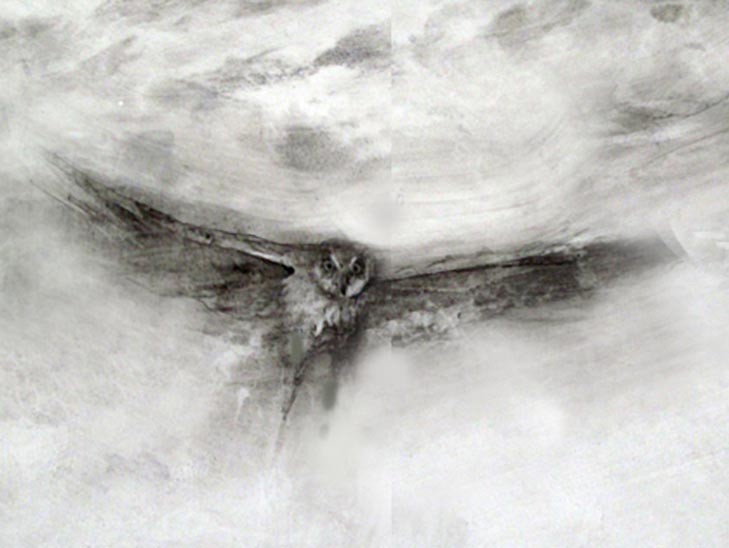
Every autumn, when the air tastes of apples and leaves crunch underfoot, my thoughts turn to tiny owls – northern saw-whet owls (Aegolius acadicus) to be exact. Just eight inches in length with a round head and bright yellow eyes, the saw-whet is arguably New England’s most endearing owl. Deer mice, I suspect, would beg to differ.
Saw-whets are small, secretive, nocturnal, and very often silent. As a result, until relatively recently, their migration patterns were poorly understood. Project Owlnet, a network of researchers spanning much of North America with a particular concentration in the northeastern U.S., is changing that.
For five Octobers, I volunteered at one of their research sites in southwestern New Hampshire. Every calm, clear night, we’d deploy an array of delicate vertical nets – called “mist nets” for their hazy appearance – on a forested hillside. In the middle of the array was a portable speaker, programmed to broadcast an audio loop of the saw-whet’s high-pitched toot-toot-toot call, loud enough to be heard from above.
If we were lucky, when we returned in half an hour, the recording would have lured a curious saw-whet (or two or three) into our nets. The researchers would then carefully extract each owl from the tangle of filament and carry it in a soft cloth bag to the banding station: a fold-up camp table sporting a lantern, a kitchen scale, a binder of data sheets, and an assortment of small scientific tools. There, they would weigh and measure the owl, examine the wear on its feathers with a black light to determine the bird’s approximate age, and place a lightweight, numbered metal band around its leg before releasing it back into the night.
Afterwards, we’d sit around in our camp chairs, swapping stories, sipping hot chocolate, wishing we’d remembered our long johns, and crossing our fingers that we’d find an owl on the next net run.
The owl banders I worked with have since moved on to other careers in conservation, but those nights at the banding station left an indelible impression on me. They also contributed to what we now know about saw-whet migration in the Northeast.
Over the course of five years, more than 500 saw-whet owls were captured, recorded, and released at the banding sites in our corner of New Hampshire. Twenty of the birds had originally been banded elsewhere: Vermont, Massachusetts, New York, Pennsylvania, New Jersey, Maryland, Virginia, Quebec, Ontario, even Michigan. Twenty-one of the owls originally banded in New Hampshire were later encountered in Vermont, Maine, Massachusetts, New York, Connecticut, Pennsylvania, or West Virginia. One bird was captured in Keene, New Hampshire a full six years after it was first banded in the Berkshires, an intriguing find for a species whose lifespan in the wild rarely exceeds a decade.
The New Hampshire station was part of a much larger effort. According to a review of saw-whet migration data published in 2011, biologists collectively banded an astounding 81,584 fall-migrating saw-whet owls in eastern North America between 1999 and 2008. During that time, only 2,184 (less than 3 percent) were recaptured.
Despite the low recapture rate, data from the more than 100 banding stations associated with Project Owlnet have revealed several trends. Saw-whets typically begin moving south from Canada in late September, with some birds traveling thousands of miles each year between nesting sites in the boreal forest and wintering grounds in the central and southern U.S. In the northeastern U.S., they tend to arrive when fall foliage nears peak color. Movement drops off significantly three to four weeks after leaf-fall.
Saw-whet migration also appears to be tied to a four-year cycle in small rodent populations at their breeding grounds, which is in turn tied to mast production. Years with more nuts and seeds produce more rodents, resulting in more saw-whets. With this boom comes increased competition for food, forcing juvenile owls to fly farther afield in search of prey. During an irruption year, these “hatch-year” birds can swell the ranks of migratory saw-whet populations tenfold.
Females generally travel farther than males, and males in the southern part of the breeding range may not migrate at all. Some saw-whets travel along the coast. Others seem to follow mountain ranges. There is still much to learn.
Unless you’re a mouse or a birder, you probably haven’t given much thought to the silent, winged predators that emerge after dusk. This fall, when you’re lighting your woodstove or snuggling into your flannel sheets in anticipation of the season’s first hard frost, pause for a moment. Open a window or, better yet, step outside. Breathe in the crisp autumn air, peer out into the dark, and imagine them: a tribe of tiny owls – hushed, fierce, adorable – passing through, unseen, in the night.


Discussion *